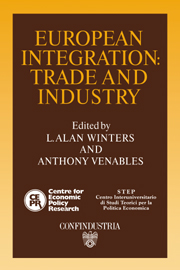Book contents
- Frontmatter
- Contents
- List of figures
- List of tables
- Preface
- Acknowledgements
- List of conference participants
- 1 European integration: trade and industry
- 2 Completing the internal market in the EC: factor demands and comparative advantage
- Discussion
- 3 External effects and Europe's integration
- Discussion
- 4 The quality and production of textiles and clothing and the completion of the internal market
- Discussion
- 5 Competition and imports in the European market
- Discussion
- 6 The structure and determinants of East–West trade: a preliminary analysis of the manufacturing sector
- Discussion
- 7 1992 and EFTA
- Discussion
- 8 Technology policy in the completed European market
- Discussion
- 9 Corporation tax, foreign direct investment and the single market
- Discussion
- 10 Japanese direct manufacturing investment in Europe
- Discussion
- Index
Discussion
Published online by Cambridge University Press: 07 September 2010
- Frontmatter
- Contents
- List of figures
- List of tables
- Preface
- Acknowledgements
- List of conference participants
- 1 European integration: trade and industry
- 2 Completing the internal market in the EC: factor demands and comparative advantage
- Discussion
- 3 External effects and Europe's integration
- Discussion
- 4 The quality and production of textiles and clothing and the completion of the internal market
- Discussion
- 5 Competition and imports in the European market
- Discussion
- 6 The structure and determinants of East–West trade: a preliminary analysis of the manufacturing sector
- Discussion
- 7 1992 and EFTA
- Discussion
- 8 Technology policy in the completed European market
- Discussion
- 9 Corporation tax, foreign direct investment and the single market
- Discussion
- 10 Japanese direct manufacturing investment in Europe
- Discussion
- Index
Summary
This study describes the integration of a computable model of production and trade under conditions of increasing returns to scale and product differentiation into a general equilibrium framework. Traditional computable general equilibrium (CGE) models are specified on the basis of ‘textbook comparative advantage’; they thus permit inter-industry trade only, or allow for ad hoc product differentiation and hence intra-industry trade by assuming that products are distinguished by country of production. Norman (1990), using a simple three-sector–two-region example, suggests that the inclusion of imperfect competition has a significant effect upon the quantitative effects of changes in trade policy in CGE models.
The basic model applied here is very similar to that usefully employed by two of the authors in a partial equilibrium context (Smith and Venables, 1988), excepting that in this case there is no allowance for economies of scope and hence the number of varieties of a product produced is fixed. In this study the links between the individual industries are provided via the explicit modelling of intermediate demand and the specification of factor demand equations and overall resource constraints.
The principal result presented in this study is that market integration within the EC will have differing effects on various types of labour. The predicted changes in factor prices suggest that the United Kingdom, for example, has an unexploited comparative advantage in high-skilled labour-intensive products, whilst after 1992 the rest of the EC will further exploit its advantage in unskilled labour-intensive products. This tends to confirm the analysis of Neven (1990) based upon differences in average wages between EC countries.
- Type
- Chapter
- Information
- European IntegrationTrade and Industry, pp. 30 - 33Publisher: Cambridge University PressPrint publication year: 1991



